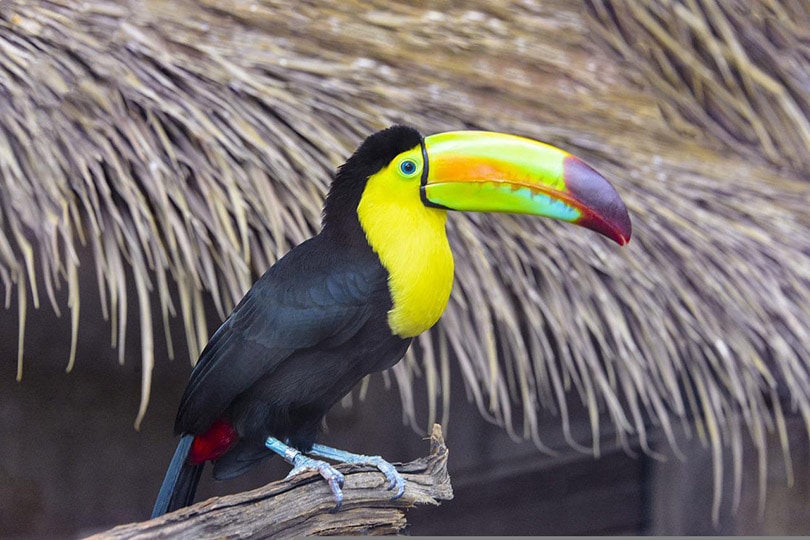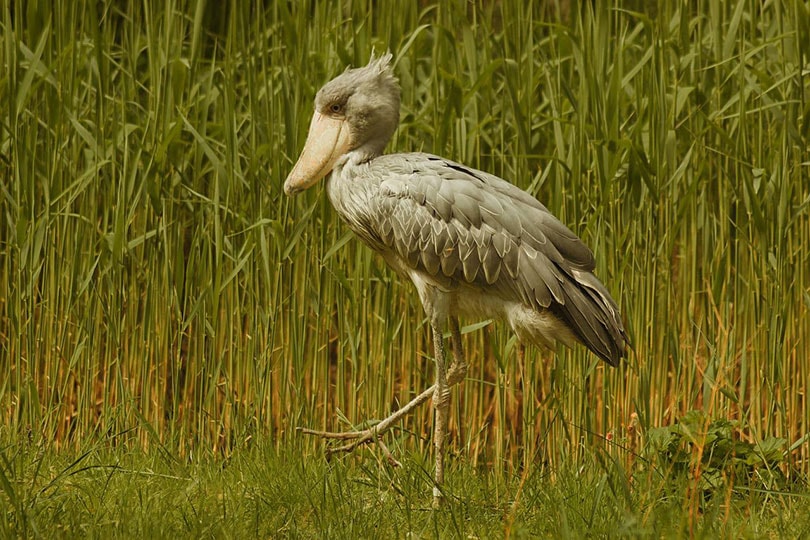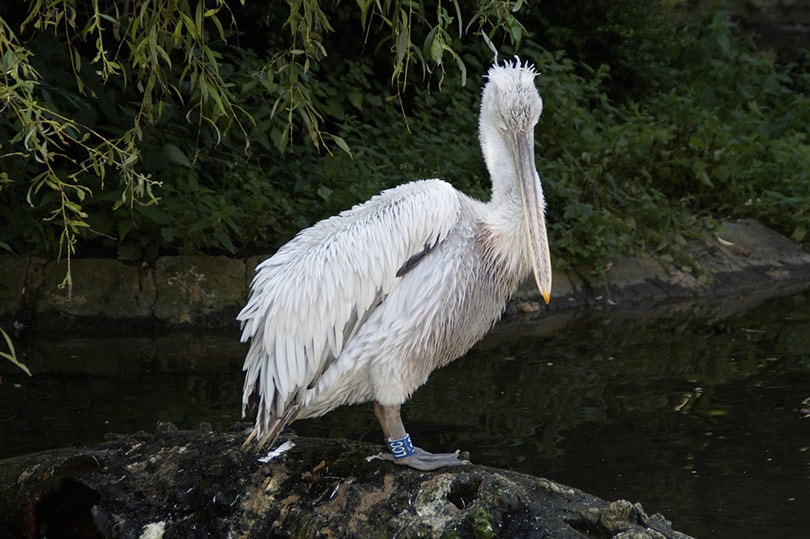15 Birds with Long Beaks (With Pictures)
Last Updated on

You can tell a lot about a bird just by glancing at its beak. That’s right— a bird’s beak isn’t just a cool physical feature. Instead, it tells you a lot about a bird’s diet, ecological niche, habitat, and size.
The best part about birds’ beaks is that they vary greatly. You’ll rarely find two different birds with the same beak, as they can be long, short, thin, thick, downturned, upturned, colorful, and monotonous.
You must keep in mind that the beak length cannot be determined by the beak alone. It’s also essential to take the bird’s body length into the equation. This way, you’ll know whether the beak is long or not.
If you want to know all about birds with long beaks, you’re at the right place. We have listed the top 15 birds with long beaks, ranging from exotic to familiar.

Why Do Birds Have Long Beaks?
It’s important to know that birds don’t just have longer or shorter beaks for no reason. Each type of beak has a purpose and long history of evolution. In addition, their diets and habitats are significant influences on their beak size.
For example, you’ll see long and curved beaks on fish-eating birds, such as seagulls, pelicans, and albatrosses. This shape and length help them catch the fish without letting it escape.
Pelicans have big pouches under their beaks, which help them store large gulps of water with fish in them. Herons and cranes also use their long and strong beaks to catch fish efficiently. Birds that feed on nectar, such as hummingbirds, dig their sharp and long beaks into flowers to find their food.
On rare occasions, you’ll even find birds with spatulate beaks, such as the Spoonbill, to help them pick up small animals and mollusks from the base of marshes and ponds. In addition, swans, ducks, and flamingoes have wide and flat beaks, which feature filtering systems that help them clean dirt from pond water.
The 15 Birds With Long Beaks
Here are the top 15 birds with long beaks, and we’ve included their scientific name, beak length, and body length.
1. Black Skimmer

| Scientific Name: | Rynchops nigra |
| Beak Length: | 3–4 inches |
| Length: | 16–20 inches |
The Black Skimmer is a seabird that looks like a seagull, but it’s different in many ways. Its beak is incredibly sharp and turns from orange to gray. A notable feature of this bird is that its feet are the same orange shade as its distinctive beak.
The lower mandible of the beak protrudes from under the upper part of the beak by a few centimeters. As a result, a Black Skimmer’s beak can be about 3–4inches long compared to its 16–20-inch-long body.
Black Skimmers hunt their prey by skimming the lower mandible of their beak against the water’s surface, easily catching small fish and other organisms.
2. Shoebill

| Scientific Name: | Balaeniceps rex |
| Beak Length: | 7.4–9.4 inches |
| Length: | 43–60 inches |
The Shoebill is another stork. Its other names include Whale-Headed Stork and Whalehead since it has a massive beak that resembles the shape of a shoe.
The upper mandible of a Shoebill’s beak is strongly keeled, becoming a very sharp nail at the end. These birds use this dangerous tip for self-defense. In addition, Shoebills tend to clatter their beaks around their nests or greet other birds.
Their large beak is in the same muted tones of their body, better described as a dull peach. It measures 7.4–9.4 inches long compared to their bodies which can be about 43–60 inches. This bird lives around large swamps in South Sudan or Zambia in tropical East Africa.
3. Great Hornbill

| Scientific Name: | Buceros bicornis |
| Beak Length: | 9–10 inches |
| Length: | 3.1–3.9 feet |
The Great Hornbill has a unique beak that can be 9–10 inches long. What makes the beak unique is that it features a casque on top of it, essentially a hollowed structure. Male Great Hornbills use this casque to fight other males or attract female Great Hornbills.
Their body length can range from 3.1–3.9 feet, and they’re primarily found in the Malay Peninsula, mainland Southeast Asia, and Indonesia. They prefer to reside in tall, wet, evergreen forests that cater to their nesting necessities.
Male Great Hornbills spread the preen gland secretion on their feathers and beak, giving them a bright yellow color. Their beaks also have a black commissure and serrated edge wearing out over time.
4. Keel-Billed Toucan

| Scientific Name: | Ramphastos sulfuratus |
| Beak Length: | 6–8 inches |
| Length: | 19–20 inches |
You’ve probably seen a Keel-Billed Toucan before; they’re known for their colorful and disproportionate bodies. Their beaks are approximately one-third of the entire body.
Their keratin beaks are much lighter than you may think. This is because they’re completely hollow inside and have a few thin rods of bone for support. The colorful appearance is what makes their beaks so unique.
They’re mainly lime yellow with an orange stripe down the middle and a sharp, red tip. Currently, scientists are unsure about the purpose of such large beaks for Kill-Billed Toucans, but they believe they use them for self-defense and courtship displays. But, of course, they also use their beak to eat fruits and sometimes insects, reptiles, other birds, and eggs.
5. Great Spotted Kiwi

| Scientific Name: | Apteryx haasti |
| Beak Length: | 3.5–4.7 inches |
| Length: | 18–20 inches |
The Great Spotted Kiwi is one of the most popular birds since it’s the national bird of New Zealand. They’re very small, flightless, and nearly wingless. They’re members of the same families as ostrich, cassowary, and emu, which all share one feature: the lack of a special ridge in their sternum.
Their beaks are long, thin, and sharp. Compared to its 18–20-inch body, its beak length is commonly 3.5–4.7 inches. The upper part of their beak protrudes against the lower mandible.
Sometimes, kiwis use their beaks as levers to widen holes as they move them back and forth. Then, it puts its entire weight into its beak by positioning it into a headstand. Once they’ve captured the worm, they move delicately to not break the form.
These birds also feature whiskers around their beak, which is rare for the bird class.
6. Long-Billed Curlew

| Scientific Name: | Numenius americanus |
| Beak Length: | 4.4–8.6 inches |
| Length: | 20–26 inches |
Long-Billed Curlews have one of the thinnest beaks of all birds. It’s worth noting that this is the longest shorebird in the United States.
The Long-Billed Curlew uses its long, curved beak to look for their meals of aquatic invertebrates by probing sand and mud. Unfortunately, they also use their beaks to look for grasshoppers in the American Great Plains’ grasslands breeding grounds. As a result, they’re able to protect crops from grasshoppers.
These birds spend their winters on beaches, tidal estuaries, mudflats, and flooded fields. You’ll find them amongst crowds of other shorebirds, such as Marbled Godwits and Willets. You won’t have any trouble finding them because their long-necked, long-billed silhouette is obvious.
7. Roseate Spoonbill

| Scientific Name: | Platalea ajaja |
| Beak Length: | 4–6 inches |
| Length: | 28–32 inches |
The Roseate Spoonbill has an unusual, spatulated, and long beak. Since these birds feed on shallow birds, they use their flat beaks to sift out the dirt by moving their hide side to side rapidly.
Their nostrils are the base of their beak, so they can still breathe while their beaks are underwater.
It’s worth noting that Roseate Spoonbills are vulnerable to destroying nesting and feeding habitats. Plume hunters destroyed wader colonies in the 1860s, which resulted in these birds being virtually removed from the United States. In the 20th century, they began to recolonize Florida and Texas.
8. Lesser Flamingo

| Scientific Name: | Phoeniconaias minor |
| Beak Length: | 5–7 inches |
| Length: | 3–3.4 feet |
The Lesser Flamingo is another unique bird found in South Africa and known for its beautiful appearance. They have uniquely shaped, hook-like beaks that are wide, long, and dark. Lesser Flamingos use their beaks to feed on tiny planktonic organisms in the water. They filter the water over their tongue before it goes down their throat.
They most commonly inhabit estuaries, saline lakes, salt pans, and large alkaline environments. However, sudden environmental changes affect them significantly, so Lesser Flamingos travel up to 280 miles daily to reach a suitable environment.
9. Rhinoceros Hornbill

| Scientific Name: | Buceros rhinoceros |
| Beak Length: | 9.2–12 inches |
| Length: | 37–41 inches |
The Rhinoceros Hornbill is named after its resemblance to the rhinoceros. What makes its beak unique is the eye-catching casque above its beak. The keratin cask acts as a resonating chamber to amplify bird calls.
As a result, their bird calls are heard throughout the Indonesian rainforests they live in. These beaks are a beautiful combination of red, orange, and yellow hues.
They use their beaks to feed on fruits, small birds, small reptiles, and rodents and create unique nests.
10. American White Pelican

| Scientific Name: | Pelecanus erythrorhynchos |
| Beak Length: | 10–14 inches |
| Length: | 4.2–5.4 feet |
Everyone has seen an American White Pelican at least once or twice in their lives, but the purpose behind their strange beaks is quite interesting.
Their beaks aren’t just long and wide, but the lower mandible is a pouch where they store food and water. They repeatedly scoop fish and water into their mouth by opening and closing their mouth.
American White Pelicans also aid other herds of birds with eating and hunting. During the breeding season, a lump forms on their beaks and falls off after mating or laying eggs. Scientists haven’t yet discovered the purpose of this lump, but it’s essentially a display of fertility.
11. Dalmatian Pelican

| Scientific Name: | Pelecanus Crispus |
| Beak Length: | 14–18 inches |
| Length: | 5–6 feet |
The Dalmatian Pelican is about 5–6 feet long, while its beak ranges from 13–18 inches. Their bodies and beaks are similar to the American White Pelican, except that Dalmatian Pelicans have spotted wings.
Their beaks are a muted, off-white shade with a bright yellow tip. They use this beak to scoop up their food like any other pelican. These birds also utilize their beaks to groom themselves or spread waterproofing oil on their feathers. Simply put, you’ll find them making use of their beaks.
Dalmations Pelicans are also one of the most giant birds today, boasting an 11-foot wingspan.
12. European White Stork

| Scientific Name: | Ciconia ciconia |
| Beak Length: | 5–8 inches |
| Length: | 3.3–3.8 feet |
The European White Stork has a 5 –8 inches long, extremely sharp, orange beak. They use their beaks to feed on scorpions, frogs, fish, snakes, small mammals, eggs of ground-nesting birds, insects, spiders, tadpoles, lizards, and crustaceans. Yes, they eat pretty much anything.
They look for their prey by walking around with their beak pointed directly at the ground. Once the prey is found, they stab it with their sharp beak and swallow it instantly. European White Storks are found in North Africa, the Middle East, Asia, and Europe.
13. Australian Pelican

| Scientific Name: | Pelecanus conspicillatus |
| Beak Length: | 15–17 inches |
| Length: | 5.2–6.2 feet |
The Australian Pelican looks different from other pelicans in many ways. Their long and wide beak is more of a dull peach color with a bright yellow tip.
They use their beaks to scoop up water with small fish, birds, and other scraps to eat. You’ll mainly find Australian Pelicans in Australia and Tasmania since these countries have waters that supply sufficient food to scoop into their beaks.
14. Toco Toucan

| Scientific Name: | Ramphastos toco |
| Beak Length: | 7.5 inches |
| Length: | 25 inches |
The Toco Toucan has the biggest beak of the entire bird class. These birds are known for their colorful beaks, which are more for aesthetics than any other purpose.
Their long and wide beaks are a mix of red and yellow hues with a sharp, curved, black tip. Unfortunately, a Toco Toucan’s beak is a poor weapon since it’s a mere honeycomb of keratin. So instead, they simply use their beak to deter predators.
Other than that, their beaks help them regulate their body temperature by changing the blood flow. This helps them distribute heat away from that part of the body.
15. Southern Yellow-Billed Hornbill

| Scientific Name: | Tockus leucomelas |
| Beak Length: | 3.5–5 inches |
| Length: | 19–24 inches |
Last but not least, the Southern Yellow-Billed Hornbill has one of the most dangerous beaks. You may have seen its animated rendition of Lion King. Their beak has earned the nickname “Flying Banana” since it’s curved and bright yellow.
Their beaks also feature a casque, which helps them amplify their bird calls throughout the African Savannah. In addition, a female Southern Yellow-Billed Hornbill’s beak is shorter than a male’s
These birds use the sharp ends of their beaks to jab at their prey, swallow them immediately, and leave some behind for smaller mammals. Isn’t that considerate?

FAQs
Here are the answers to the most frequently asked questions about birds with long beaks.
Why Do Birds Have Different Lengths of Beaks?
It’s easy to think that birds have certain lengths, shapes, and beak colors because they suit their bodies, but that’s not the case. Instead, a bird’s beak’s size, length, shape, and color have certain purposes.
Birds’ beak designs evolve according to their diet and lifestyle. Their habitat is another factor that influences beak size. For example, birds that feed on fish and water have deep and long beaks to store their food. Birds that need to pick out dirt from ponds and marshes have filtering systems, and so on.
What Do Birds Use Their Beaks For?
Of course, the main purpose of a bird’s beak is to eat, but there’s a lot more that birds do with their beaks than just eating. It’s a very rare occasion that birds have long beaks just for aesthetic purposes. Birds feed themselves with their beaks, but they also feed their young with them.
In addition, birds use their beaks to pick up twigs and leaves and assemble their nests. Besides that, they also use their beaks to clean and groom themselves (or scratch an itch). Lastly, birds use their beaks to defend themselves.
Which Bird Has the Longest Beak?
The bird with the world’s longest beak is the Australian Pelican. Their beaks measure in at about 13–18.5 inches long. However, the bird with the longest beak in relation to its overall body size is the Sword-Billed Hummingbird. This beak measures roughly 4 inches long, which is longer than their overall body length, with the tail excluded.

Conclusion
Now that you’ve read our complete list of the top 15 birds with long beaks, you surely know that birds’ beaks aren’t just cool physical features. Instead, their beak is strongly influenced by their habitat, diet, and ecological niche. We hope our list helped expand your knowledge of birds and their long beaks.
Featured Image Credit: MOHANN, Pixabay
Table of Contents
- Why Do Birds Have Long Beaks?
- The 15 Birds With Long Beaks
- 1. Black Skimmer
- 2. Shoebill
- 3. Great Hornbill
- 4. Keel-Billed Toucan
- 5. Great Spotted Kiwi
- 6. Long-Billed Curlew
- 7. Roseate Spoonbill
- 8. Lesser Flamingo
- 9. Rhinoceros Hornbill
- 10. American White Pelican
- 11. Dalmatian Pelican
- 12. European White Stork
- 13. Australian Pelican
- 14. Toco Toucan
- 15. Southern Yellow-Billed Hornbill
- FAQs
- Conclusion
About the Author Jeff Weishaupt
Jeff is a tech professional by day, writer, and amateur photographer by night. He's had the privilege of leading software teams for startups to the Fortune 100 over the past two decades. He currently works in the data privacy space. Jeff's amateur photography interests started in 2008 when he got his first DSLR camera, the Canon Rebel. Since then, he's taken tens of thousands of photos. His favorite handheld camera these days is his Google Pixel 6 XL. He loves taking photos of nature and his kids. In 2016, he bought his first drone, the Mavic Pro. Taking photos from the air is an amazing perspective, and he loves to take his drone while traveling.
Related Articles:
Monocular vs Telescope: Differences Explained (With Pictures)
10 Types of Hummingbirds in Arkansas (With Pictures)
8 Types of Hummingbirds in Nebraska (With Pictures)
5 Types of Hummingbirds in Idaho (With Pictures)
3 Types of Hummingbirds in Mississippi (With Pictures)
8 Types of Hummingbirds in Kansas (With Pictures)
5 Types of Hummingbirds in West Virginia (With Pictures)
5 Types of Hummingbirds in Ohio (With Pictures)
